1. High Mountains- Including the Altai Mountains and Tavan Bogda
Mongolia is a mountainous country. Though the high mountain zone, which includes the higher elevations of these ranges, makes up only about 5 percent territory of Mongolia, average elevation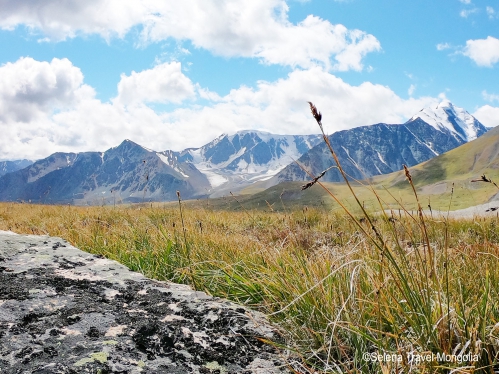 of the country is quite high, at 5,184 feet (1,580 m.) above sea level. In the Far Western Altai, Khuiten Peak in the top parts of Tavan Bogda Mountains reaches 14,350 feet (4,374 m.), the highest point in the country. Altai, Khangai and Khentii mountain ranges and the Khuvsgul Mountains are higher than the height of forest zone. Many mountain areas of Mongolia show signs of previous Ice Ages, with U-shaped valleys and boulders left behind by retreating glaciers. The climate in the high mountain zone is extremely cold, and there is a short growing season. Located above tree line, the zone is characterized by tundra, alpine-sedge meadows, highland swamps, and lichen-covered boulder fields.
of the country is quite high, at 5,184 feet (1,580 m.) above sea level. In the Far Western Altai, Khuiten Peak in the top parts of Tavan Bogda Mountains reaches 14,350 feet (4,374 m.), the highest point in the country. Altai, Khangai and Khentii mountain ranges and the Khuvsgul Mountains are higher than the height of forest zone. Many mountain areas of Mongolia show signs of previous Ice Ages, with U-shaped valleys and boulders left behind by retreating glaciers. The climate in the high mountain zone is extremely cold, and there is a short growing season. Located above tree line, the zone is characterized by tundra, alpine-sedge meadows, highland swamps, and lichen-covered boulder fields.
Highest Mountains of Mongolia:
|
Nairamdal peak (Tavan Bogda Mountain)
|
14,350 feet (4,374 m.)
|
|
Sukhbaatar peak (Munkhkhairkhan Mountain
|
13,806 feet (4,208 m.)
|
|
Tsast Mountain (Altai mountain range)
|
13,793 feet (4,204 m.)
|
|
Tsast Bogda Mountain (Sutai mountain range)
|
13,417 feet (4,090 m.)
|
|
Khatuu Mountain (Siilkhem mountain range)
|
13,217 feet (4,029 m.)
|
|
Khukh serkh (Deluun mountain range)
|
13,186 feet (4,019 m.)
|
2. Mountain Forest Steppe
Taiga zone which covers 5 percent of Mongolian territory occurs only in
Northern Mongolia, where it is found in the Khentii Mountains, in the mountainous terrain around Lake Khuvsgul, part of Tarvagatai mountain range, higher areas surrounding Orkhon river valley
and some parts of the Khan Khukhii mountain range. The taiga zone experiences more precipitation (12 to 16 inches annually) and lower temperatures than most of Mongolia, therefore plant growing period is comparatively short.
3. Mongolian Steppe
Steppe covers nearly the entire far-
Eastern region of Mongolia, extending west in a narrowing band just south of the Khangai and Khan Khukhii Mountains all the way to the
Depression of the Great Lakes. Mongolia's steppe is part of a vast plain that begins in Eastern Europe and reaches to the steppes of Manchuria. This steppe zone includes a distinctive group of flora and fauna. In the central and western areas of the country, the steppe provides many of the nation's most important grazing lands for domestic livestock. The steppe is vulnerable to impacts from overgrazing, agriculture, roads and other human activities.
4. Desert Steppe
Desert steppe occupies a large band, more than 20 percent of Mongolia's total area, extending across the country between the steppe and desert zones. This zone includes the Depression of the Great Lakes, the Valley of the Lakes, and most of the area between the Khangai and Altai mountain ranges, as well as the eastern Gobi area. The zone includes many low-lying areas, soils with salt pans, and small ponds. The climate is arid with frequent droughts and annual precipitation of 4-5 inches (100-125 mm.). Frequent strong winds and dust storms strongly impact the area's vegetation. Still, many nomadic herders of Mongolia occupy this zone.
5. Gobi Desert
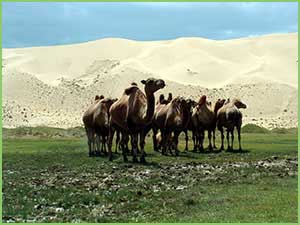
The Gobi is one of the great deserts in the world, occupying much of
Southern Mongolia and northeastern China and composing the northern part of Central Asian deserts. Starkly beautiful, the expanses of the fabled Gobi are rugged and inhospitable. Vegetation is sparse here, and the zone displays a remarkable variety: from rocky mountain massifs to the flat pavement-like areas of the super-arid desert, from poplar-fringed oases to vast outwash plains and areas of sand dunes. These areas provide habitat for many threatened species of Mongolia, including the wild camel, Gobi bear, and wild ass. The climate there is extreme. Precipitation may fall only once every two to three years and averages less than 4 inches (100 mm.) annually. Temperatures climb as high as 104° F (40° С) in summer, and fall as low as 104° F (-40° С) in winter. During the spring and fall, dangerously strong winds buffet the area with dust storms and wind-speeds up to 140 km/ hour.
Fauna of Mongolia
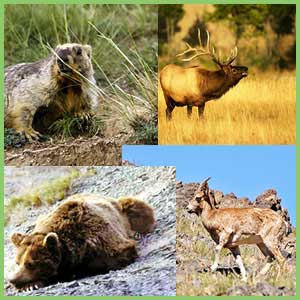
The scientific study of Mongolian fauna was started in the second half of the 19th century. Many traveling in Mongolia may find it difficult to distinguish between wild and domesticated animals as both roam freely on the open, vast steppe. Though Mongolia does not have the large games such lion or elephant that attract visitors to Africa, it has many rare and endangered species such as the snow leopard, Argali and Ibex.
Mammals in Mongolia
Currently 136 species of mammals in 8 classes, 22 families, 70 types have been registered in Mongolia; most of them are endemic to Central Asia. Roughly 60 species of them are hunted as they are considered game animals.
Reptiles in Mongolia
Currently 22 species of reptiles have been registered in the country. These include phyla pipiens, teratoscincus przwalskii, cyrtopodion elongatus, laudakia stoliczkana, phrynocephalus vesicular, phrynocephalus helioscopus, lacerta agilis, lacerta vivipara, eryx tataricus, elaphe dione, coluber spinalis, elaphe schrenckii, natrix natrix, vipera berus, qkistrodon halys... most of these reptiles are endemic.
Amphibians in Mongolia: 2 types, 4 families of 8 species of amphibians have been observed in Mongolia such as Bufo danatensis, Salamandrella keyserlingii, Rana chensinensis, Hyla japonica, bufo raddei, ...some of the amphibians are endemic.
Birds of Mongolia:
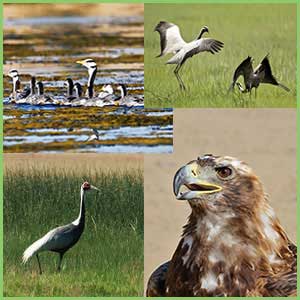
Mongolia has a rich composition of bird species due to the migratory routes from the Pacific and Indian Oceans to the Mediterranean Sea and to Arctic Ocean and Northern Tundra... 426 species of birds have been observed in Mongolia- 322 species or 78% are migrated. 30 species of birds are included in the "Red book of Mongolia" as they are concerned as rare and endangered. And some lakes as Khovsgul, Uvs, Khar Us, Dayan, Dorgon, Terkhiin Tsagaan and also some rivers where high density of birds is observed have been strictly protected partially. Birds such as Grus leucogeranus, Grus vipio, Chlamydotis undulata, ciconia migra, Pelecanus crispus, Platalea leucorodia, Anas formosa, Limnodromus semipalmatus, Larus relictus have been protected.
Fish of Mongolia: Mongolia has 75 species of fishes. Fish that are not listed in the "Red book of Mongolia" are sport fish. Common fish in Mongolia: taimen, great kalyga, strugeons, arctis cisco, siberian whitefish, pikes- amur pike, northern pike, cyprinid fish, carp, roach, dwaft altai osman, mongolian grayling, Mongolian redfin, haitej sculpin... Mongolia is the best place for river fly-fishing.
Insects in Mongolia: Insect life is the richest in the wild life of Mongolia as 13000 species of insects are observed in the country.
Flora of Mongolia
Mongolian vegetation presents special features which have developed through time in response to local landscape, environmental factors, and climate. Mongolia is a site of convergence with flora originating both in the Great Siberian Taiga and the central Asian steppe and desert.
Mongolia has acquired plant species from Manchuria in the east and from the Kazakhstan-Turan area in the west. The gradual transition from high mountain taiga, to mountain forest steppe, to flat grassy plains, and on to semi-desert and true desert, offers unique opportunity to see vegetation from different vegatation zones. This is reflected in the change in precipitation and plant distribution, from foothills to the tops of mountain ranges in vertical belts. Mongolia has over 2,823 plant species, while central Siberia has 2,400 and Inner Mongolia has 2,176.
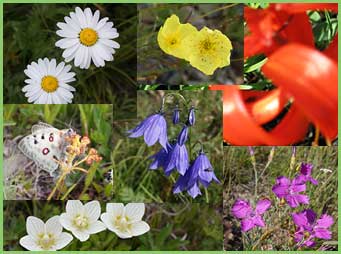
There are 845 species of medicinal plants; over 1,000 of fodder plants; 173 of food plants; 489 of ornamental plants; and 195 of other significant plants. Mongolia has 2,095 species of herbaceous plants and 348 species of woody and shrubby plants.
These comprise 17 species of big trees; 40 species of low trees and gig shrub; 146 species of shrub; 48 species of sub-shrubs; 91 species of partial sub-shrubs; 6 species of fodder and herbaceous; 1,765 species of longevity plants; 330 species of one- and two-year vascular plants; 21 families of flat moss; 38 families of leafy moss; 53 families of lichen; 1,236 species and sub-species of algae; and 900 species of mushrooms. There are relic species from prehistoric desert, forests, tertiary lakes, savannahs and the Ice Age in particular, many native to Mongolia.
There are about 150 endemic vascular and lower plants, such as stipa mongolorum; adonis mongolica; betula mongolica; atraphaxis bracteata; calligonum gobicum; nanophyton mongolicum; gymnocarpus przewalskii; silene mongolica; potaninia mongolica; chesneya mongolica; astragalus gobicus; oxytropis ulzii-chutagii; and armisia gobica.
Great Lakes Water of Mongolia
According to long term studies, Mongolia gets 230 mm of average annual precipitation . The most of it evaporates and only 10% stays on the surface, of which 37% waters the soil and 63% supplies the surface water-rivers and streams. 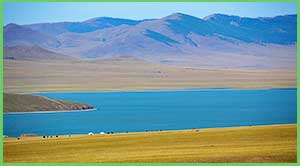
6898 springs are currently in use. Most of Mongolia's 3500 lakes are located in the western and northern parts of the country, some notable lakes are Uvs, Khovsgul, Khyargas, Khar, Boon Tsagaan, Orog, Achit and many more. 1194 lakes of Mongolia do not dry all the year around. Mongolia has comparatively high levels of surface and ground water resources. The rivers of Mongolia belong to the inland drainage basins of the Arctic Ocean, the Pacific Ocean and Central Asia.
The north has a larger network of rivers and streams than the south. The longest river is the Orkhon at 1124 kilometers in length. There are some 3000 rivers in total with a combined length over 67,000 kilometers. There are over 3000 big and small lakes, nearly 6,900 springs, 190 glaciers and 250 mineral water springs. The glaciers in Mongolia, cover 540 square km. The biggest glacier of the country Potanin is in the Altai Mountains and has a total area of 107.9 square km.

 of the country is quite high, at 5,184 feet (1,580 m.) above sea level. In the Far Western Altai, Khuiten Peak in the top parts of Tavan Bogda Mountains reaches 14,350 feet (4,374 m.), the highest point in the country. Altai, Khangai and Khentii mountain ranges and the Khuvsgul Mountains are higher than the height of forest zone. Many mountain areas of Mongolia show signs of previous Ice Ages, with U-shaped valleys and boulders left behind by retreating glaciers. The climate in the high mountain zone is extremely cold, and there is a short growing season. Located above tree line, the zone is characterized by tundra, alpine-sedge meadows, highland swamps, and lichen-covered boulder fields.
of the country is quite high, at 5,184 feet (1,580 m.) above sea level. In the Far Western Altai, Khuiten Peak in the top parts of Tavan Bogda Mountains reaches 14,350 feet (4,374 m.), the highest point in the country. Altai, Khangai and Khentii mountain ranges and the Khuvsgul Mountains are higher than the height of forest zone. Many mountain areas of Mongolia show signs of previous Ice Ages, with U-shaped valleys and boulders left behind by retreating glaciers. The climate in the high mountain zone is extremely cold, and there is a short growing season. Located above tree line, the zone is characterized by tundra, alpine-sedge meadows, highland swamps, and lichen-covered boulder fields.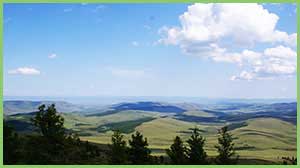

 The scientific study of Mongolian fauna was started in the second half of the 19th century. Many traveling in Mongolia may find it difficult to distinguish between wild and domesticated animals as both roam freely on the open, vast steppe. Though Mongolia does not have the large games such lion or elephant that attract visitors to Africa, it has many rare and endangered species such as the snow leopard, Argali and Ibex.
The scientific study of Mongolian fauna was started in the second half of the 19th century. Many traveling in Mongolia may find it difficult to distinguish between wild and domesticated animals as both roam freely on the open, vast steppe. Though Mongolia does not have the large games such lion or elephant that attract visitors to Africa, it has many rare and endangered species such as the snow leopard, Argali and Ibex. Mongolia has a rich composition of bird species due to the migratory routes from the Pacific and Indian Oceans to the Mediterranean Sea and to Arctic Ocean and Northern Tundra... 426 species of birds have been observed in Mongolia- 322 species or 78% are migrated. 30 species of birds are included in the "Red book of Mongolia" as they are concerned as rare and endangered. And some lakes as Khovsgul, Uvs, Khar Us, Dayan, Dorgon, Terkhiin Tsagaan and also some rivers where high density of birds is observed have been strictly protected partially. Birds such as Grus leucogeranus, Grus vipio, Chlamydotis undulata, ciconia migra, Pelecanus crispus, Platalea leucorodia, Anas formosa, Limnodromus semipalmatus, Larus relictus have been protected.
Mongolia has a rich composition of bird species due to the migratory routes from the Pacific and Indian Oceans to the Mediterranean Sea and to Arctic Ocean and Northern Tundra... 426 species of birds have been observed in Mongolia- 322 species or 78% are migrated. 30 species of birds are included in the "Red book of Mongolia" as they are concerned as rare and endangered. And some lakes as Khovsgul, Uvs, Khar Us, Dayan, Dorgon, Terkhiin Tsagaan and also some rivers where high density of birds is observed have been strictly protected partially. Birds such as Grus leucogeranus, Grus vipio, Chlamydotis undulata, ciconia migra, Pelecanus crispus, Platalea leucorodia, Anas formosa, Limnodromus semipalmatus, Larus relictus have been protected.

